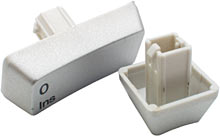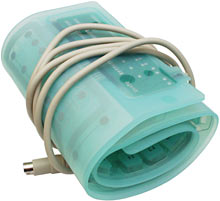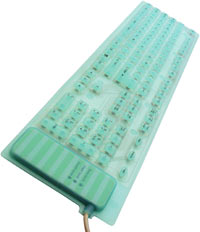
Skyhawk novelty keyboards
Review date: 21 October 2001.
Last modified
03-Dec-2011.
If you've got a black and silver computer, it's now possible to get yourself a black and silver keyboard to match, cheap.
And here it is. It's made by Skyhawk (though don't expect to find it on their less-than-fabulous site), and if you're blind, you'll think it's exactly the same as their other cheap rubber-dome-switch 'boards. There's a perfectly normal complement of quite unremarkable keys (including the somewhat questionable Windows "Power", "Wake Up" and "Sleep" keys...), and a normal PS/2 connector on the end of the cable, and the usual little flip-down stand thingies on the underside.
But this 'board happens to have been made in colours to match the décor of the forces of intergalactic benevolence.
The finish on the shiny keys isn't immaculate, but it'll pass all but close inspection. Bright chrome they're not, but then again, this matte-silver finish won't show fingerprints, either. And bearing in mind that this keyboard costs only $AU33 delivered from Aus PC Market (who, by the way, no longer stock either of these keyboards; as of 2003, this review's a couple of years old) you really can't complain.
The "silver" keys are actually made of normal beige plastic; the silver is a painted finish. The silver could, I suppose, eventually wear off. More plausibly, it could be scratched off if you drop things on the 'board.
But never mind the quality. Feel the price.
This keyboard, like most on the market today, uses rubber dome keyswitches that give reasonable tactile feel, though it's nothing compared with the clicky action of a proper buckling spring 'board. Lots of people are perfectly happy with rubber dome keyboards. These keyswitches are pretty durable, they're reasonably quiet, and they're cheap.
And there's not a huge amount more I can say about this product.
So it's just as well that along with the black and silver keyboard, I got a much weirder one for review.
Bendy-board!
This, too, is a keyboard. Only it's rolled up.
This is another Skyhawk-brand product. It costs $AU88 delivered from Aus PC Market, and it's suspiciously similar to a variety of other efforts in the same genre. I think that the first such product was the quite expensive Flexboard, but I wouldn't stake my life on it; there are now several other brands of bendy-board, and a few of them look just like this one. They come in various cheerful colours.
All of these keyboards are basically a silicone rubber envelope with key-shaped bulges in the top of it, each of which contains a keyswitch. Under all of the switches is a contact matrix that works the same way as a normal rubber dome keyboard's - the rubber domes each have a conductive pad on the bottom that bridges contacts on the matrix - but which is made to survive a lot of flexing.
A lot of rubber keyboards are quite expensive, though; some of them, like the Flexboard, are really made to last and may be suitable for use in really hostile environments. Some of the others that look just like this one, though, cost rather more for no obvious reason.
Laid out flat, this keyboard has the same area and key spacing as a normal full sized 'board, and almost the same key layout, too. The space bar's split into two small keys, because there's a limit to how big you can make a key that can't have any rigid components inside it. There are also two annoying "nothing keys" on either side of the space bar, which make it significantly narrower than normal.
Apart from that, though, this 'board has, if anything, a more standard layout than the black-and-silver Skyhawk; it's got the same "Power", "Wake Up" and "Sleep" keys, but they're above the keypad where the indicator LEDs normally go. This allows the nine keys above the cursor key block to be laid out in the usual three-plus-six pattern, not the three-by-three block they're squeezed into on the other 'board by the special Windows keys.
The rubber 'board has, by the way, perfectly normal "Num Lock", "Caps Lock" and "Scroll Lock" LEDs; they're just at the extreme right end, where the PS/2 cable enters the rubber envelope.
The cable entry point is the only place where water can get into this keyboard, and it seems pretty well waterproofed even there. A smear of silicone sealant around the edge would finalise things, but this keyboard is definitely splashproof in standard form, and would probably be fine for complete shallow immersion as well. You couldn't use it at anything more than kitchen-sink depth, though. The keys aren't very strongly sprung (which is a good thing; they'd be a complete nightmare to type on otherwise), so water pressure will press them all at once if you take the keyboard deeper than snorkel depth.
Close up, you can see the ghost of the rubber-dome keyswitch inside this key, and the truncated-square-pyramid side design that provides much of the keys' springiness. The silicone rubber shouldn't perish, will resist a lot of abuse quite well (though it's easy enough to cut), and can be readily washed clean.
The contact matrix is visible through both sides of the rubber 'board. In the style stakes, this thing is a winner.
And it is really, really bendy. I don't know how much of this sort of vigorous folding the switch circuits could tolerate, but you don't need to pinch the thing to get it folded right over like this. You ought to be able to roll and unroll this keyboard as often as you like. Which means that it is, unquestionably, far more easily portable than any other full-sized 'board.
But what's typing on the bendy-board like?
Pretty darn nasty.
I would go so far as to say that this thing is less of an input device, and more of a torture device.
You can type on it. I'm doing it now. And you can even do it without looking at the keyboard. The keys are all where you expect them to be, after all.
And it's easily the quietest keyboard I've ever used. It sounds more or less as if you're typing on a thick blanket laid over your desk.
But.
The keys on this thing squirm under your fingers. They're just rubber blocks with buckling sides, and there's nothing to force the top of the key to stay parallel to the desk when you press it, so it just collapses downwards at an angle determined by the direction your finger pushes it, and then wiggles when one side's squished as far as it can go and the other one evens up a bit. It's something like crossing a creek using wobbly stepping-stones.
I don't know whether the squirmy-key thing is an ergonomic disaster or not, but it's uncomfortable enough to make me suspect that it might be. And it's certainly disconcerting.
This keyboard is also, inescapably, always at the same angle as the surface you put it on. There's no way to make it tilt towards you relative to the desk, as all good keyboards should.
The mini-size split space bar's not as annoying as you might think. Any half-decent typist ought not to be pressing the middle of the space bar very often anyway. But its small size is a bit of a pain. I find myself missing spaces fairly often.
There's also very little tactile feedback to tell you when you've pressed a key properly; you don't get a "click", just one generalised "squish".
Normal rubber dome keyboards like the black and silver Skyhawk are bad enough in this respect, compared with proper clicky keyswitches, but they're still streets ahead of this rubber 'board.
When you don't have an obvious end-point click, you'll probably find yourself typing harder, to make sure every keystroke counts. That's bad for your hands.
Buckling-spring keyboards make a lot of racket compared with other keyswitch technologies, which often causes people to think that they're hitting the keys harder. But they actually, usually, aren't. The bendy-board's light key spring means it can be typed on with only moderate pressure, but you've got to train yourself to do it.
If you don't have a flat surface to put the rubber 'board on, it'll still work, but you may wish it didn't. If you're forced to type with this keyboard in your lap, you can still use it - for suitably small values of "use" - but you're not going to have a good time, or be able to get into any sort of normal typing rhythm.
Switching back to my IBM keyboard after using the bendy-board was a great relief.
Overall
The buying decision for the black and silver Skyhawk 'board is a simple one. If you want a basic, cheapo PS/2 keyboard that's black and silver, then here one is. It's not a top quality product, but it should last as long and work as well as any similarly cheap 'board. And its unusual looks may be exactly what you need to match your funkalicious modded computer case, or your appropriately decorated office, nightclub or bondage parlour.
The rubber 'board, on the other hand, is a product with some definite niche applications. It will probably also be bought just 'cos it's cool by various people who don't need it, will be annoyed by it, and will then go back to using their normal keyboard.
If your keyboard is regularly subjected to liquid insults, or if you really need to travel very light indeed, or if your number one requirement of a keyboard is that it make very close to no noise at all, then the rubber keyboard will meet your needs better than any other product so far.
If you want something that's nice to type on, though, stay well away from this floppy novelty.










